At almost every home inspection with a sump system, we make recommendations for improved safety, performance, or both. Here are five common sump system defects, in no particular order.
1. A loose or missing sump basket cover
This is a safety issue because a small child could drown if they fell into a sump basket.
The fix is quite simple; if there’s no cover, install one. If the cover is loose, get a few screws and run the screws right through the cover into the sides of the sump basket. A good rule of thumb is to also make sure the sump cover can support someone’s weight, for obvious reasons.
Ideally, the sump cover should also be airtight. This will help to prevent radon gases from entering the home, as well as moist air.
Side note: the photo below shows a hilarious repair to a hole in the sump cover. The conversation probably went like this:
“How should I seal up my sump cover?”
“Use some all purpose cement.”
“10-4.”
Ok, just one more. I can’t help myself. Please don’t use hand grenades to seal up your sump pump either. I’m only saying this because we’ve seen it done.
2. A missing check valve
A check valve should be installed on the discharge pipe to prevent water in the discharge tubing from dumping back into the sump basket after the pump shuts off.
This is also a simple fix; check valves cost about $10 and they’re easy to install.
Side note: if you find a 3/16″ hole in the disharge line above the sump pump, this is not a defect. The sump pump manufacturer requires this weep hole to help prevent airlock. Water will shoot out of this hole when the pump is running, and this is perfectly normal.
3. An undersized discharge pipe
Sump pumps typically have a 1-1/4″ or 1-1/2″ outlet. The size of the discharge tubing should match this; that means don’t even think about using a garden hose. You’ll reduce the capacity by more than 80%. Remember πr²?
Using undersized discharge tubing, even at the exterior, will force the pump to run longer each time it turns on, decreasing the life of the pump. Some smaller pumps may come with an adapter for a garden hose, but I think it’s still a terrible idea.
The fix for this condition is simple; use larger tubing. Inside the house, use ABS or PVC tubing. Outside the house, it’s fine to switch over to corrugated stuff. Home improvement stores sell 25′ lengths of corrugated tubing for under $10, and connecting this is a piece of cake.
4. Discharging water right against the house
When a sump pump discharges water right up against the house at the exterior, the water runs right back down to where it came from. Dumb.
While this might seem obvious, it’s not obvious to everyone, or people simply don’t understand what is happening, because we find this defend very often. The discharge tube from the sump system should terminate at a point where the water will drain away from the building. Using the corrugated stuff I mentioned above is a good way to make this happen.
And for the love of love, don’t try to use one of those downspout entender thingies.
Oh, and if you want to be a good neighbor, keep the discharge tube in your own yard ;-).
5. A potential for freezing at the exterior
I’m embarrassed to say that I actually had this happen to me once. I typically remove my discharge hose at the exterior in the fall, but one year I forgot to do it. Wate froze inside the tubing, completely blocking it. One morning I noticed a low humming noise that never stopped, and I found my sump pump running continuously, unable to pump the water out. I can only imagine how long the pump had been running before I found out about it, and how many years of service this stupid mistake might have removed from my pump.
While disconnecting the drain hose at the exterior will prevent the sump discharge from being blocked by ice, there’s another way to prevent blockage that doesn’t require any maintenance. Simply have the sump pump discharge to an air gap. This way, if the discharge tubing fills with ice at the exterior, water will still make its way out. It will end up discharging right up against the house if the tubing is frozen, but it’s better than not discharging at all, and the amount of water that a sump pump pumps during the winter should be minimal.
The photo below shows the sump pump discharging to a receptor that connects to a 4″ corrugated drain hose.
Just be sure to significantly increase the size of the drain hose if going with this method; if the drain hose isn’t large enough, water will overflow very quickly.
Or if you want to get really fancy, you could install check valves at the exterior with different pathways for the water depending on the season.
Related Post: Backup Sump Pumps
Quick Links: Missing cover | Missing check valve | Undersized discharge | Short discharge | Potential for freezing

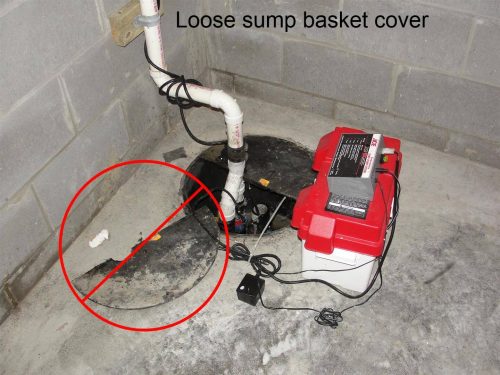
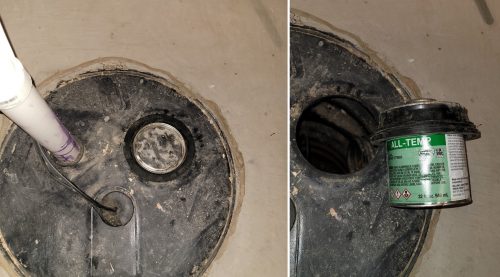
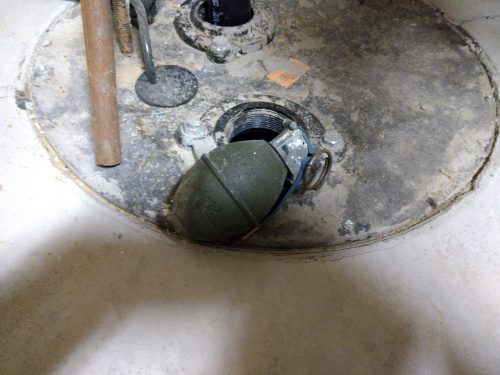
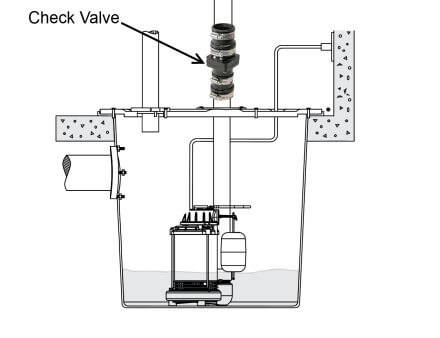
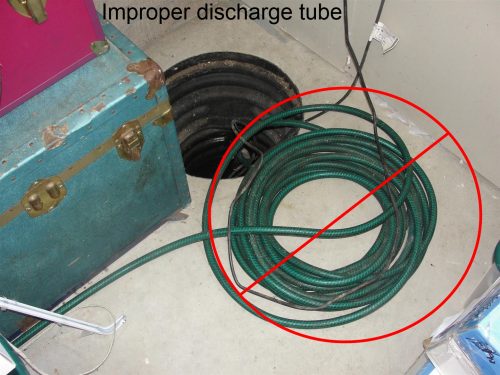
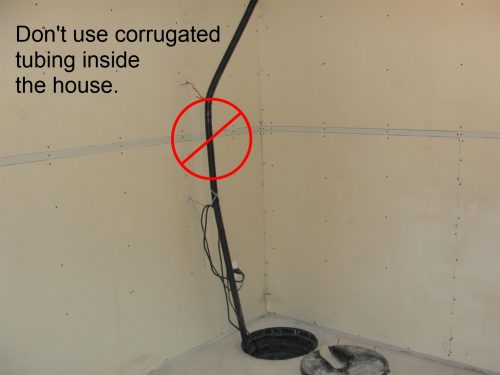
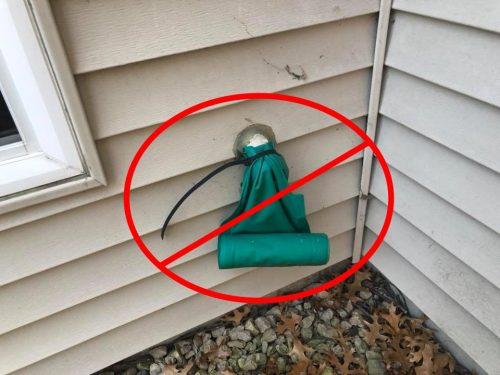
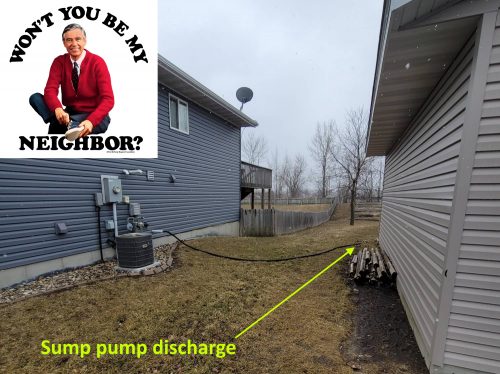
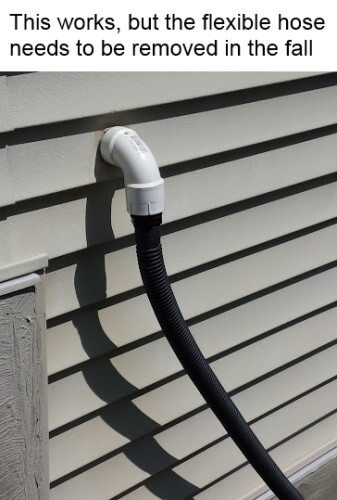
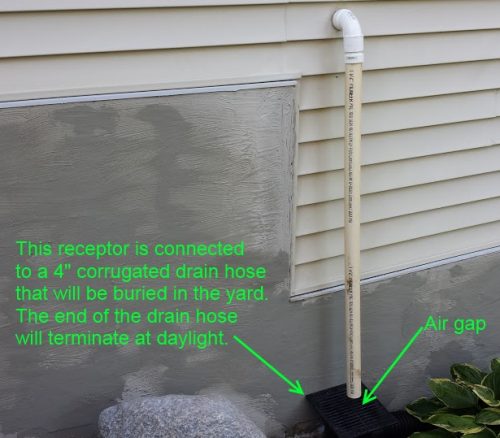
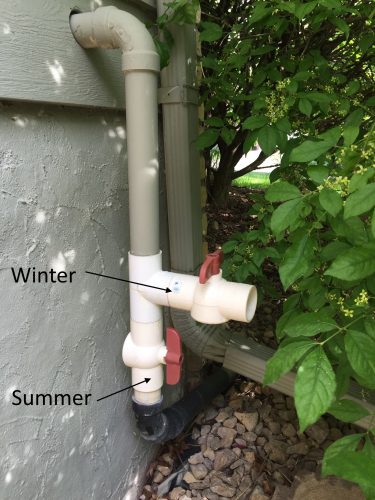
Sump Pump Discharging to the City Sewer | Structure Tech Home Inspections - Part 1
July 30, 2013, 4:28 am
[…] thing to do is to make the sump pump discharge to the exterior. In last weeks post on sump system defects, I gave some advice on how this could be done without having the line get blocked with ice during […]
Jack attack
August 2, 2013, 8:09 pm
I have tried to discharge outside in the winter as my sump pumps runs all year. I have tried your idea and it doesn’t work in the cold of Minnesota if your home is built on clay. Give me an answer on how to not discharge outside in the winter that works and I’ll do it. Otherwise it’s not worth ruining my basement over
Don't connect downspouts to yard drains | Structure Tech Home Inspections - Part 1
August 6, 2013, 3:43 am
[…] is the same stuff that I mentioned in a recent blog post while discussing sump pumps discharging to a yard drain. Just like the discharge tubing from a sump pump, connecting a downspout directly into an […]
Cougar Land
October 13, 2013, 10:41 pm
Real question to ask is why water is getting frozen in the line. Something is wrong on the other end that it gets surrounded with water and frozen up. It depends on your setup. If you are in a city or place that has storm drains to the road, you should be able to connect sump pump solid all the way out with no problem. But I don’t believe you’re allowed to connect downspouts to storm drains though.
Dave Matheson
November 18, 2013, 12:13 am
What are the dangers that come with freezing at the exterior? Especially when you leave it at that for quite a stretch of time?
Reuben Saltzman
December 15, 2013, 8:01 am
If the discharge hose is filled with ice and the pump runs, the water won’t discharge. The pump will just keep running, possibly overheating and failing.